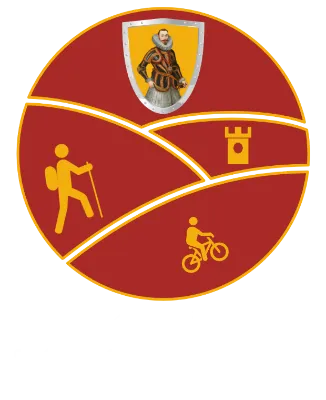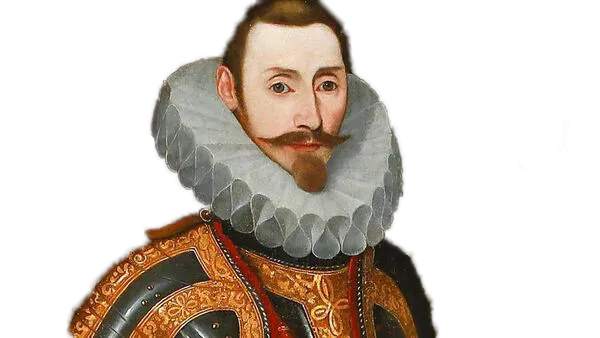Tipperary Clans
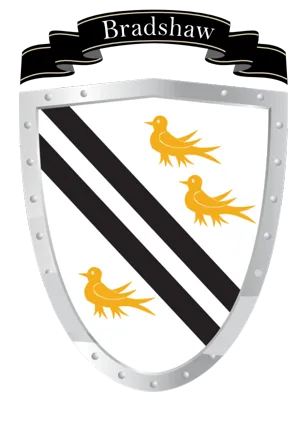
Bradshaw
The name Bradshaw in Ireland was brought into the country in the seventeenth century, mainly into Ulster and County Dublin. It is in the Northern Counties as well as Dublin and Tipperary that descendants with this name can still be found.
Motto: Qui vit content tient assez. He who lives content holds enough.
Other branches of the clan: Bradshaigh, Bradshay, Bradshawe, Braidshaw, Bradeshaw, Bradsher
The name Bradshaw was prevalent from ancient times in England. It is a name of Norse origin, from the Scandinavian Vikings, who crossed the North Sea and raided the Northern Coasts of Britain from the 8th Century. Some of them established fortified settlements there, and many place-names and personal names in North-East England are of Viking origin.
The name Bradshaw is probably derived from the Old Norse words broddr (spike), skagi (tip), skaga (to jut out) and skogr (forest), possibly relating to the shape of a particular wood or copse close to the Viking settlement where the Bradshaws first dwelt.
The name is also related to the Old English (Anglo-Saxon) words brord (point, nail) and sceaga (thicket).
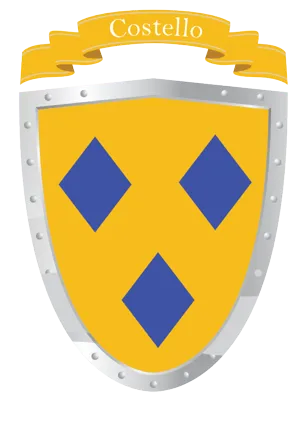
Costello
Motto: Ne te quaesiveris extra. Seek nothing beyond your sphere.
The Irish surnames Costello, Costelloe, and Costellow are anglicized forms of the Gaelic surname Mac Oisdealbhaigh, itself a Gaelicized form of an Anglo-Norman name. This was the first example of a Norman family assuming a Gaelic name.[2]
This surname has been mainly borne by a notable Irish family who claimed descent from Jocelyn de Angulo, an Anglo-Norman mercenary who accompanied Richard de Clare to Ireland in 1170 during the Anglo-Norman invasion of Ireland.
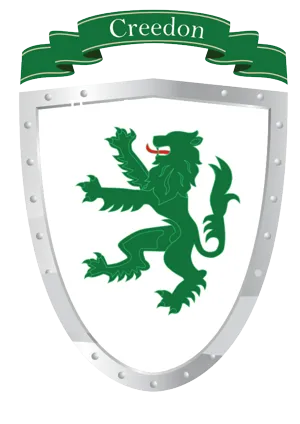
Creedon
Mac Críodáin, Gaelic-Irish surname, anglicised as Creedon.
This surname originated in medieval Munster, being found especially in Thomond, Ormond, and Desmond (now counties Clare and Limerick, County Tipperary, and counties Waterford and Cork).
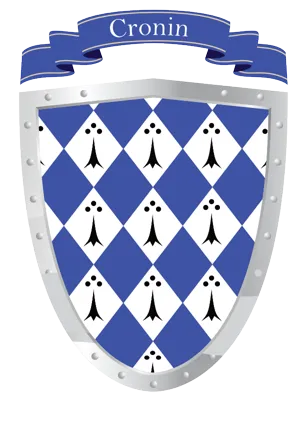
Cronin
The Irish surname Cronin is an anglicized version of the Gaelic name Ó Cróinín, which means "descendant of Cróinín." The name is primarily associated with County Cork in the southern part of Ireland, where it has been present since medieval times.
Variations of the name include Cronan, Cronen, and Cronyn.
Motto: Virtute Vici. Conquered by virtue.
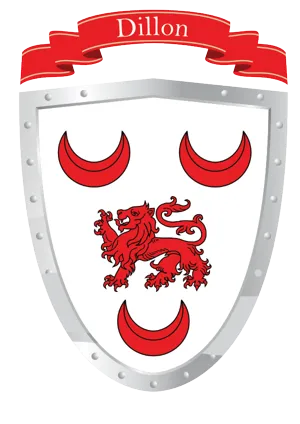
Dillon
The surname is one of the Anglo-Norman names that arrived in Ireland in the wake of the 12th century invasion by Richard "Strongbow" de Clare, 2nd Earl of Pembroke. The surname Dillon belongs to the large category of Anglo-Norman habitation names, which are derived from pre-existing names for towns, villages, parishes, or farmsteads.
From its origins as "Diolun" in the Irish language, the name Dillon has become synonymous with two counties in particular: Meath and Westmeath. It's a name that resonates throughout the land, a testament to the vast tracts of land that the Dillons were granted.
The family went on to become the Barons Clonbrock and Earls of Roscommon, weaving their influence through the fabric of Irish society.
Motto: Dum spiro spero. I hope while I breathe.
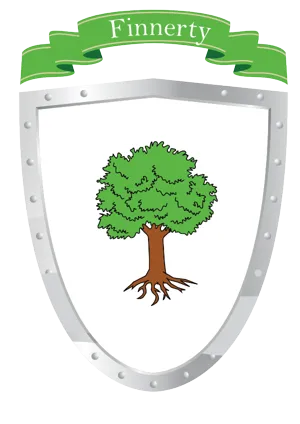
Finnerty
The surname Finnerty has Irish origins and means "Fair snow". The Celtic version of the name is "Fionnachta" or "O' Fionnachta". The word "Fionn" means "fair" and "Sneachta" means "snow". It refers to people with snow-white hair or skin. Queen Meave of Connacht is believed to be one such person. The word "Fionnachtaí" means "discoverer" and "inventor" in English.
When Ireland came under English control in the 1600s, the Celtic family names were translated roughly, distorting their meanings. Ó Fionnachta was transformed into Finnerty by one scribe and had other variations as well. The earliest recorded reference of a permanent Finnerty birthplace is linked with an ancient fortress where Donamon Castle now stands. The castle is believed to be one of the oldest and longest-inhabited sites in Ireland. The first "Fionn Sneachta" King of Ireland reigned from 1277 to 1257 BC, according to the Annals of the Four Masters.
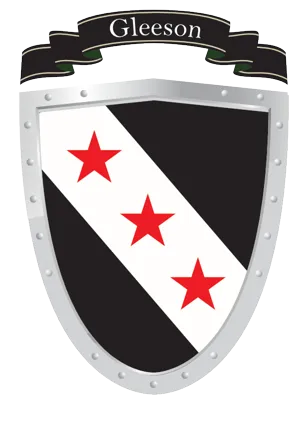
Gleeson
Gleeson is an Irish surname that has a rich history. It comes from the Irish names Ó Glasáin or Ó Gliasáin, which were anglicized to become Gleeson. This name is most commonly found in County Tipperary, but its origins can be traced back to East County Cork.
The Gleesons were once powerful lords and even kings in the Uí Liatháin kingdom. Their influence can still be seen today in the area where they once ruled. Despite the passage of time, the history and heritage of the Gleeson name still hold great importance.
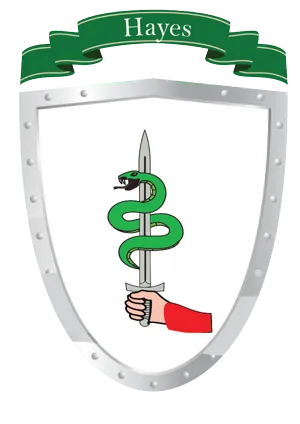
Hayes
Hayes is a surname that comes from Ireland. Originally, it was spelled as "O hAodha" in Gaelic. That means "descendant of Aodh" or "descendant of the Irish god Aed".
In most counties, people changed the spelling to "Hayes". But in County Cork, it's "O'Hea". And in Ulster, it's "Hughes". Hayes has been around since at least 1182, and some Hayes families are part of the McNamara or O'Carroll clans.
Mottos: Audaces fortuna juvat. Fortune favours the bold.
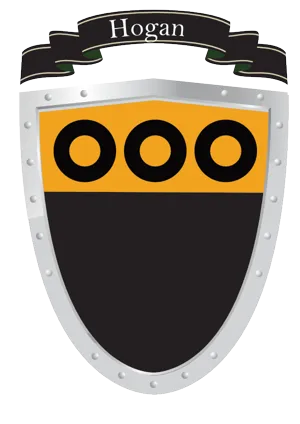
Hogan
The word Hogan derives from the Gaelic 'An O hOgain' (Og meaning "young"), in Irish mythology, the land of eternal youth is called Tir Na nÓg.
The Hogans were a Dalcassian family descended from Ogan, who was a direct descendant of Brian Boru, the last great High King of Ireland who defeated the Vikings in 1014 A.D. They came from Clare and Limerick divided and spread across Tipperary. The Hogans lost their lands under the Cromwellians but had some land re-granted by Charles II.
Motto: Fulminis instar. Like lightning.
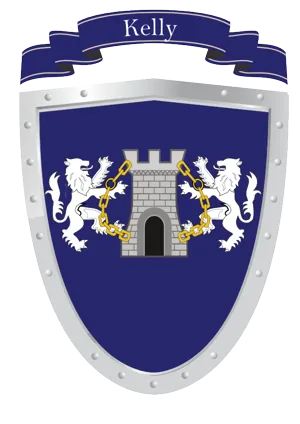
Kelly
Kelly is a name with Irish roots that has multiple meanings. It can mean "descendant of Ceallach", which is thought to mean "bright-headed" but can also mean "frequenting churches". It can also be an Anglicisation of the Irish Ó Cadhla, meaning "descendant of Cadhla".
The O'Kelly or Kelly of the Clan Brasil Mac Coolechan is a chieftain clan of the Ulaid, and their surname has been passed down through generations.
Motto:Turris fortis mihi deus. God is a tower of strength to me.
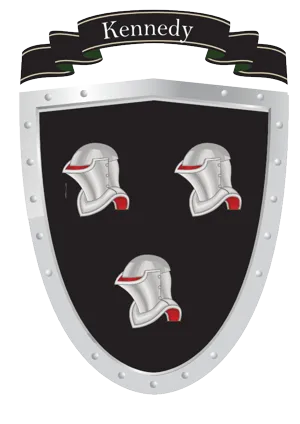
Kennedy
The O'Kennedy family was a royal dynasty from Ireland that was a part of the Dál gCais sept. They were the Kings of Ormond and were started by the nephew of High King Brian Boru. Brian Boru was also known as the High King of Ireland and his father's name was Cennétig mac Lorcáin, King of Thomond. The name Cinnéide was Brian Boru's father's name and it belonged to him.
The Kennedys were not directly related to Brian Boru but to his father's eldest son, Donncuan. They started calling themselves Ó Cinnéide, which means grandson of Cinnéide, and became known for their long-standing presence in the region with placenames like Killokennedy in Thomond.
Motto: Avise la fin. Consider the end.
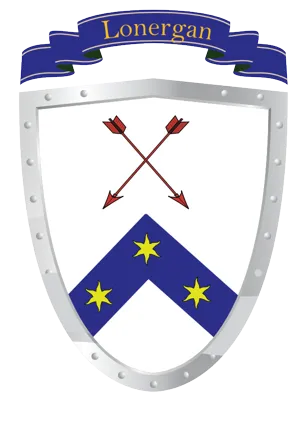
Lonergan
The O'Lonergans were a powerful clan in ancient times, and even had three archbishops of Cashel among their ranks. Despite being dispossessed by the Butlers in the fourteenth century, the sept still exists in significant numbers today, mainly in the Cashel and Cahir area. Their name, O Longairgain, means "without a ships crew" and is often seen as Lonergan or Londrigan. While they did provide some notable ecclesiastical figures, they largely stayed out of politics.
The history of the Lonergan clan stretches back centuries, with their origins in the area north-east of Thomond. However, the Anglo Norman Butlers proved too powerful and pushed the sept southward to Cashel and Cahir. Despite this displacement, the name Lonergan still persists in the region today. Interestingly, the O'Lonergans were not active participants in politics, instead focusing on producing notable members of the clergy. It's fascinating to see how some families can endure through time and change, carrying with them their own unique histories and stories.

MacEgan
The MacEgan family of Ireland was known for their learning and literary contributions, rather than military prowess. They held high positions in Irish society as judges and professors, and were one of only seven families to practice the Brehon Law. Their influence was widespread, and their descendants can still be found in parts of Ireland today. Many members of the family were celebrated for their achievements as brehons and ollaves, and their educational tradition continued despite hardships throughout history. The Egan clan, from which the MacEgan family descended, has a long history and their surname has been spelled many different ways over time.
Mottos: With fortitude and prudence.
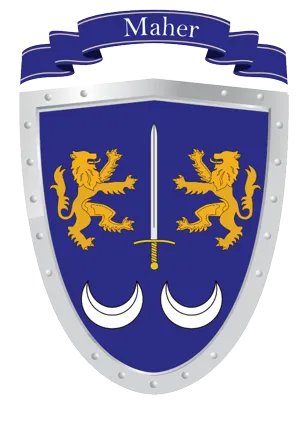
Maher
O’Meachair is an Irish surname, when translated becomes O’Maher in English eventually the ‘O’ prefix, which means son of, was dropped. The name itself translates literally into “kindly one” The Maher surname, pronounced Marr, comes from the Kilkenny and Tipperary regions of south-central Ireland with variations of the name spelled as O’Meagher, Meagher, Meager, and Mahir. In the north of County Tipperary is the Barony of UiChar’in or in English the Barony of Ikerrin. A land famed for its fighting men, and their tenacious attitudes for not giving up. The Maher family through its alliance with the Clan O’Carrol kept control of the barony all through the loss of the Ancient Kingdom of Ely and the invasion of the Normans in 1198 under Sir Richard ‘Strongbow’ de Clare. The barony was a centered around the town of Roscrea in the mountains.
Motto: In periculis judax. Bold in danger.
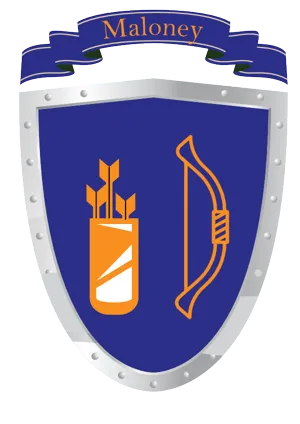
Maloney
Ua Maul Dhomhnaigh is an old Irish surname that translates to “descendant of a servant of the church” and is associated with the Moloney clan. The Moloneys were one of the oldest Irish septs and held a number of castles around their estate at Kiltannon.
The Moloney family was known for its strong religious ties, as evidenced by the many bishops they contributed. Father Donough O’Molony was tortured to death in 1601 due to his faith and Bishop John O’Molony held the diocese of Killaloe from 1630 to 1670 even during times of great religious persecution.
Throughout history, ang licized surnames associated with Ua Maul Dhomhnaigh include Maloney, Malony, Moloney, Molony, Mullowney and Malowney (but not Malone or Mahony). These names are still present in areas of Ireland such as Clare, Limerick and Tipperary.
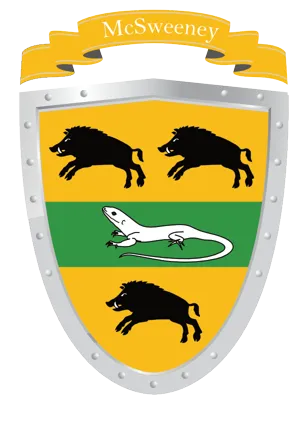
McSweeney
The name McSweeney might sound Irish, but its origin is actually Norse-Gaelic. It comes from the Gaelic surname Mac Sween or Swein, which means "son of Suibhne". Suibhne may sound Irish too, but the eponymous ancestor was actually of Norse-Gaelic descent.
Swein, Son of Cinaid, King of the Gal-Gaidhil, is mentioned in the Annals of Tigernacht as having died in 1034 AD. Claims that the McSweeneys descend from the O'Neills are false. This fabrication may have been made up to smooth their way into medieval Tyr Connail, where they became kingmakers and protectors of the ruling O'Donnells.
McSweeneys have a long history in Ireland, and their influence stretches back centuries to the time of the O'Donnells. The McSweeneys were an important part of the Tyr Connail society during medieval times, where they served as powerful allies and protectors of the ruling family. Their power and influence also extended to other parts of Ireland, where they made alliances with other clans and served as mercenary warriors.

O'Brien
Ó Briain, a Dalcassian sept, derives its name and importance from the family of King Brian Boru. O'Brien is now a very popular name in all provinces of Ireland including Munster.
The family clans of the O’Brians have great importance in Ireland. This is mainly due to their illustrious predecessor, the great Brian Born, King of Leinster and Munster, who fought the Vikings at the Battle of Clontarf.
The surname O’Brian comes from the Irish name, as Gaeilge, O’Briain, which means "son of Brian". Brian is an ancient Celtic name of uncertain origin-but the most likely explanation is that it means "hill".
Motto: The strong hand from above.
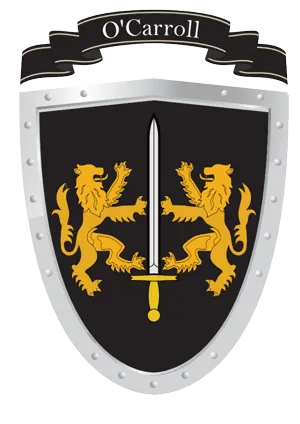
O'Carroll
The O'Carroll clan, also known as Carroll, Carrol, or Carrell, is a prominent sept of Clan Cian in Gaelic Ireland. They claim to be related to the Eóganachta, and their ancestors were descended from Ailill Aulom. Their territory, known as Ely O'Carroll, was located in Munster, and they ruled over it until surrendering to the Tudor Kingdom of Ireland in 1552. The Ely O'Carroll sept was the most famous and powerful, but there were at least four other septs of O'Carrolls in different areas of Ireland. The anglicization of the name often drops the prefix "O'," and Mac is sometimes used instead. The given name Cearbhall, from which the family name Ó Cearbhaill originates, likely means "crooked mouth" or "crooked member."
Motto: In fide et in bello fortis. Strong both in faith and war.
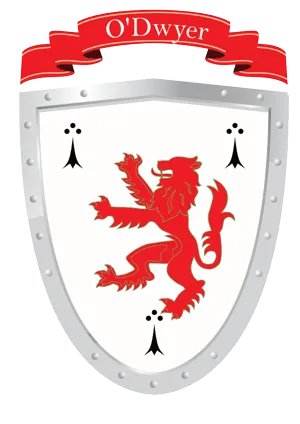
O'Dwyer
The O'Dwyer clan, known for their dark hair color, is one of the oldest Gaelic noble or aristocratic houses in Ireland. They became Lords of Kilnamanagh in the Middle Ages but didn't gain significant recognition until the 15th century. They were one of several regional Gaelic clans that resisted Anglicisation during the Lordship of Ireland.
The O'Dwyers clashed with new Norman arrivals, particularly the Butler Earls of Ormond. In 1641, two clan members, Philip and Anthony O'Dwyer, captured the Rock of Cashel during the Irish Rebellion. However, after the Cromwellian War, they lost much of their land under the Act for the Settlement of Ireland 1652. Some moved to County Clare or became Wild Geese on the European Continent, serving in armies of Bourbon France, the Habsburg monarchy, and even Romanov Russia. One O'Dwyer, Count John O'Dwyer, became the Governor of Belgrade.
The O'Dwyers were renowned for their bravery and loyalty, and in some cases even their cunning. In the 17th century, they joined the Jacobite cause during the Williamite War in Ireland (1689-91) and also fought on the continent in support of James II. One of their most famous members was Captain Donagh O'Dwyer of Lisronagh who was killed in action at the Battle of Aughrim in 1691. His memorial still stands today, a testament to their dedication and loyalty.
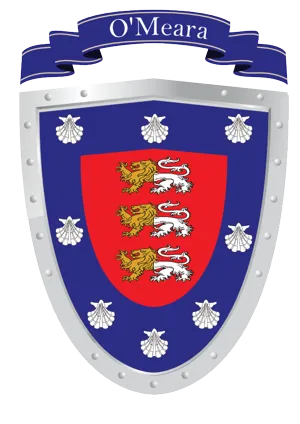
O'Meara
The Ó Meadhra clan was a group of people who were part of the Dal gCais, and their name is most commonly found in north-east Thomond (nowadays north County Tipperary and adjoining parts of County Clare.
They were known for being physicians and poets for the Earl of Ormond, and their home district was centered around Toomevara (O'Meara's tumulus).[citation needed].
The last Gaelic-era Chief of the Name was Domhnall Ó Meadhra.[citation needed]. Nowadays, the surname is anglicised as O'Meara, O'Mara or Meara.
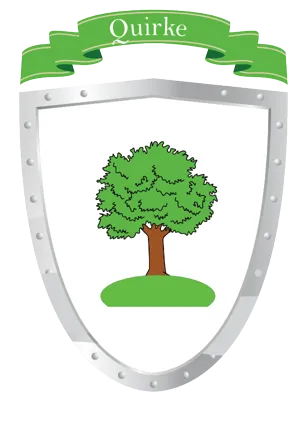
Quirke
Before the Normans came to Ireland, a family called the Quirkes ruled over a big area in Tipperary. They were called Maigh Cuirc or Muscraighe. The head of the family, Ceinnedigh O'Cuirc, was killed in 1043. There was also a thief named Murchad O'Curk who was given shelter by the Archbishop of Cashel in 1295.
The Quirkes were still in Tipperary when Cromwell invaded. Some Quirkes fought with the Ormond army in 1649 and the Irish army in the 1670s. A priest named Thomas O'Quirke was a chaplain to the Confederation of Kilkenny at the same time.

Ryan
A number of different clans make up what is now the modern surname of Ryan. The most prominent being the O’Ryans of Idrone and the O’Mulryans of Owney and Owneybeg. Other names that have changed to become Ryan include the O’Mulrennans of Roscommon, the O’Ruadhains / Ruans of Galway / Mayo and the MacRyans of Galway. The largest by number are likely to be of the O’Mulryans of Owney & Owneybeg (which is in modern day Tipperary and Limerick).
The O’Mulryans were part of the Gaelic revival in North Tipperary where Gaelic Chiefs reclaimed their lands and they held them down to the 1600s where we read of one of the last Chiefs of the O’Mulryans, William O’Mulryan, being buried at Abbey Owney. Callinan says this about the Ryans “In the insurrection of 1641, the O’Mulryans took a prominent part and as a result all their lands were confiscated under the Cromwellian regime and granted to soldiers, adventurers and others, the ancient proprietors being driven beyond the Shannon into the barren lands of Clare and Connaught”.
Motto: Malo More Quam Foedari, Death Before Dishonour.
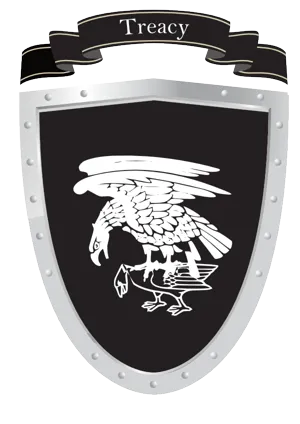
Treacy
The Irish name Tracey is derived from the native Irish O'Treasaigh Septs. The name is taken from the Irish word "treasach" meaning "war-like" or "fighter". It is also translated as "higher", "more powerful" or "superior". It may also be derived from the Irish word for three, with an association to the Tuatha Dé Danann. The first reference to the surname in the Irish Annals was in 1008AD, where it states, "Gussan, son of Ua Treassach, lord of Ui-Bairrche, died."
There were initially three distinct O’Treasaigh septs:
one in SE Galway, although they were dispersed from there at an early datethe second in west Cork, a branch of which migrated to Limerickand a third in county Laios near the Carlow border, although these were also dispersed over time.
The Trassy and O’Trassy spellings were recorded in the 1659 census. Tracy, Tracey, and Treacy appeared in Griffith’s Valuation of the mid 19th century. Tracy has retreated in favor of Treacy since that time. Sean Treacy, the young IRA leader at the time of the Irish War of Independence, came from Tipperary.

© 2023 In Tipperary, All Rights Reserved.
Web Design by Pixelweb Design
